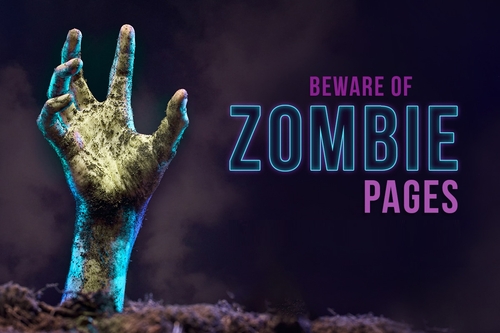Does it ever seem as if your marketing team is randomly throwing things against the wall, hoping the next campaign, email newsletter, or website update sticks? Or, do you feel like you’re always doing the same old thing, hoping this time you’ll get better results?
Whether you’re stuck in a rut or running around like chickens with your heads cut off, the antidote is a real B2B marketing strategy.
CoSchedule surveyed nearly 1,600 professional marketers and found those with a documented strategy, defined processes, audience research, and clear goals were exponentially more likely to have success than those who did not. We’re talking 200 to 500 percent more successful.
Yet, the Content Marketing Institute’s (CMI) annual survey of B2B marketers consistently indicates that the lack of a documented strategy is an ongoing problem. CMI’s 2019 B2B Content Marketing Survey found just 39 percent of all respondents had a formal plan.
Running a marketing department is chaotic. There may be times when you feel completely lost. But, when you’re armed with a B2B marketing strategy, you have a roadmap that helps you stay on course. We can’t promise it won’t be crazy at times, but we can tell you that having a plan will help you handle the insanity with confidence.
With a B2B marketing plan, you can stop hoping for results and start expecting them.
Key Differences Between B2C and B2B Marketing Strategies
A lot has been said about how B2C marketing differs from a B2B strategy. To sum it up, there are many similarities in how you develop your plan, but a B2B marketing strategy is almost always more complex and may require a more intricate thought process.
It is true that, whether it’s B2B or B2C, you are marketing to people. It’s also true that both consumers and B2B buyers will make purchase decisions based on emotions using logic to justify their choices.
You may assume that most B2B buying is based on facts, features, and pricing. Research from CEB and Google, however, found B2B organizations are even more emotionally connected to their vendors than consumers are to brands.
The stakes are often higher in the working world than in home life. Your family won’t fire you for buying the wrong loaf of bread, but your reputation and even your job could certainly be on the line if you’re the one who recommended a solution to your employer that failed miserably.
That’s why some common emotional drivers in B2B decision making include:
- Trust (we can count on you)
- Mutual respect (an understanding and appreciation of each other)
- Connection/shared beliefs (people like us work with people like this)
- Status (this will help me/our company look good)
- Fear (if we don’t do this, something bad might happen)
The feeling that prospects have about your organization boils down to branding, which is just as important for B2B companies as consumer-facing brands. Your company’s brand is much more than a logo, slogan, and a style guide. That’s why Element helps B2B clients develop what we call a Total Brand Chemistry, which documents why your organization exists and what it stands for before aligning things like logos and copywriting under the brand.
After you’ve defined your brand, you need to start delivering on the promises you make. This includes the way you conduct day-to-day business and the way you position the company through marketing.
Seven Components of a B2B Marketing Strategy
1. Define Clear Business Goals
It’s no use having a B2B marketing strategy if you’re unclear about where you want it to take your organization. The marketing team must understand how its efforts are expected to grow the business.
Marketing-specific goals are fine, but what we’re really talking about here are the business outcomes that marketing efforts are able to impact. Increasing traffic to the website is a marketing goal, increasing sales is a business goal.
Once you have clarity surrounding what the marketing department is expected to do, you can get down to the task of determining how to do it.
2. Know Your Target Audience
You may assume you already know everything there is to know about the prospects you’re trying to reach, but taking the time to research and document your audience/customers is a crucial part of a B2B marketing strategy.
An effective way to conduct audience research is through persona development. This exercise involves the creation of documents featuring hypothetical people who reflect your ideal customers. They should focus on psychographics (fears, motivations, beliefs, aspirations) over demographics (age, gender, income, location). At Element, we’ve found that writing a narrative around personas, such as a mini biography, helps bring personas to life and cements them in your memory. Include industry statistics and other existing research to support the persona stories.
These personas help you uncover the customer pain points your business can help relieve, and they inform your overall strategy, including how you develop unique marketing messages for different types of people.
An indispensable part of your audience research should involve talking to actual people who represent your prospects. These could be current customers, former customers, as well as people in your personal or professional network who match the criteria and job title. While it could be a tough conversation, you may learn the most from customers you’ve lost or those who’ve chosen not to work with you.
CMI’s survey found around 75 percent of all respondents rely on the sales team and website analytics. Yet, the most successful marketers were more likely to use original research, customer interviews, and panels as techniques for gathering intelligence about the audience.
Getting feedback from members of the sales team is an excellent resource for personal development. Just remember, sales reps may not connect with prospects until those potential customers have already done a significant amount of research relating to their needs. If sales reps tell you “all these people care about is price,” it’s likely because that’s one of the last questions your prospects have at that point.
Many other questions are answered along the way to a final decision, which is why the next element of a B2B marketing strategy is vital.
3. Map Out the B2B Buyer’s Journey
Once you have a solid understanding of your audience, you need to paint a picture of the steps they take towards choosing your business. We call this a path to purchase or buyer’s journey, and they typically involve these five phases:
- Needs Awareness
- Research
- Consideration and Comparison
- Procurement
- Loyalty
At Element, our buyers’ journeys often include a few additional steps in-between the main five. That’s especially useful in B2B marketing strategies, because B2B purchasing decisions usually involve more than one person. This is one of the main differences between B2C and B2B marketing, which should be considered during the audience research process.
In business, you could have one person who makes initial recommendations and another who conducts research and reports back to the boss. Depending on the organization, members of the C-suite may be get involved. A major purchase may even need approval from members of the board.
The B2B path to purchase tends to move up and down the chain of command. As marketers, our job is to understand who is influencing the decision and who is the ultimate decision maker. Then, you’ll have a better idea of what types of marketing efforts should be deployed and to whom they should be focused.
4. Identify Key B2B Marketing Tactics
At this point, you know who your audience is and you’ve outlined how they make decisions. Now, you can fill in the blanks. What types of marketing will move your prospects along a path to purchase, eventually persuading them to choose you?
In addition to a buyer’s journey, sales and marketing funnels are useful in developing a B2B marketing strategy. Funnels outline advertising and marketing campaigns and content meant for different stages of the buyer’s journey. At the top of the funnel, prospects are educating themselves and looking for solutions to a problem. In the middle of the funnel, they’re comparing their options and getting advice from contacts. At the bottom of the funnel, they’re reaching out to sales and making the final decision.
A common mistake at this step involves focusing on the marketing medium rather than the marketing message. Don’t assume that, for example, social media and blog content are always top of the funnel, case studies and videos are mid-funnel, and remarketing ads are meant for the bottom of the funnel.
That could be true, but you could also have a blog post that focuses on a topic meant for those near the end of their path to purchase. Or, you could write an e-book that covers a very basic, top-of-the-funnel subject, and a social media post could have a direct call-to-action to make a purchase. It’s the content itself that dictates its placement in the sales funnel, not the way that content is packaged.
As you choose marketing tactics to implement, ask yourself these questions:
- How does this fit in the path to purchase?
- Where would it fall in our sales funnel?
- Does this provide value to our prospects?
- What do we want people to do next?
You’ll need to discuss and develop ideas, always looking for where there are holes in the funnel that can be filled by marketing efforts. Is your website missing a landing page on a new service offering? Would an informational blog series explaining the various benefits of that service be useful, or would it work better as an infographic or video? Should you pay to promote content on social media or drive targeted traffic directly to the new landing page?
Once you know what you want to talk to your audience about, and the tactics you’ll use to spread the message, it’s time to start organizing your ideas into a cohesive plan.
5. Connect the Dots for an Integrated B2B Marketing Strategy
At Element, we often break our clients’ integrated marketing programs down into four categories: Owned, Earned (Public Relations), Shared (Social Media), and Paid Media. These are viewed as separate practices, but as you can see below, the intent is for them to intersect. This connectivity creates a holistic B2B marketing mix that produces better results because the separate efforts are focused on the same goals.
Before you connect the dots of all the different marketing initiatives in your plan, you must get the people that touch every aspect of marketing in alignment. That includes your internal marketing team as well as the sales team, public relations, leadership, digital/IT staff, and your agency partners. If you’re doing recruitment marketing or working on the corporate culture, you may also need to involve human resources and management. Siloed marketing efforts are doomed to fall short of expectations, so get everyone on the same page.
When it comes time to execute actual marketing tactics, you’ll want to avoid randomly creating content, posting to social channels, distributing press releases, and placing ads. Instead, go back to your business goals and your audience research to help you identify key tactics and build a web of holistic marketing around that initiative.
Here’s what we mean by that …
Let’s say you have a major tradeshow the company attends every year. You may want to build a portion of your B2B marketing strategy around that tradeshow. Use social media to generate a buzz before the event, spark conversations and make new contacts during the show. Write blog content that connects to the tradeshow’s theme or your booth that year. Use public relations to set up media interviews on that theme with your subject matter experts. Take out digital and print ads promoting your booth or speaking engagements at the show.
Here’s another example …
Your company has a new service offering this year and you need to build awareness and start converting existing and new customers. You may release a series of videos with valuable content related to that service. Those videos could be supported by short-format blog posts on the same topics as well as short video clips published on social media, all driving people to the main content. You could also land contributed articles in trade publications on topics related to your service offering, highlighting the company’s expertise in front of the right audience.
Place a core, high-value marketing effort at the center and then build a mini strategy around it.
6. Make an Editorial Calendar
Your B2B marketing strategy will have a lot of moving pieces, which is why part of documenting the plan should be to create a schedule.
A marketing calendar (or editorial calendar) clearly defines when campaigns start and end, when events, announcements, or product releases take place, and sets deadlines for when content should be written, approved, and published.
This tool helps keep teams aligned and on task throughout the year. There is a variety of software and services you can use to create these calendars. Of course, you can always use an Excel spreadsheet as well. The point is, you should get granular, documenting when individual items need to be executed.
Once you have your B2B marketing strategy mapped out and placed in a calendar, expect it to change regularly. As you’re likely familiar, very little ever goes exactly according to plan. Keep an open mind and be prepared to adjust your calendar as the need arises. But, don’t forget to update it, otherwise you’ll cause mass confusion. It’s smart to appoint one person as the keeper of the calendar.
7. Develop a Measurement Strategy
The final element of a B2B marketing strategy is imperative to defining your success. If you want to know whether your plan is working, you need to be able to measure results. Regular marketing reports using data from Google Analytics and other reporting tools should be compiled and presented to your sales and marketing teams as well as key members of the company.
The problem many marketers face is finding a way to gather valuable insights from all the marketing data that’s available. It’s easy to get stuck reporting on numbers without interpreting them and even easier to emphasize information that doesn’t mean much.
Statistics such as overall web traffic, impressions, and social media likes are often called “vanity metrics” because they make the marketing team feel as if something positive is happening, but they don’t tell the full story.
There’s nothing wrong with reporting metrics like that, but they’ll be more valuable if you can break them down a bit and connect them to the business goals you identified when you started your strategy.
Element does this in client reports using key performance indicators (KPIs) that directly relate to big picture business outcomes. These KPIs are designed to prove that marketing is working and helping our clients achieve their goals. For example, rather than only reporting on the types of web traffic that came to the site, we’d report on an engagement metric for specific content, such as scroll depth on pages covering a certain topic, and break that down into traffic types.
Good marketing reports will answer many questions, but they’ll also get you asking important questions that inform your strategy and provide you with insights indicating where to adjust. Hence, the ongoing changes to your calendar.
B2B Marketing Strategy Doesn’t Have to Be Daunting
A lot goes into creating a B2B marketing plan. When Element works on a strategy for our clients, the process takes place over a few months and results in a b2b marketing strategy full of information, research, and recommendations.
Many organizations lack the time and resources to develop a complete strategy, which is one reason why so many B2B companies operate without them. It’s tough to focus on the big picture when you’re buried in the day-to-day duties.
This is one area where an integrated marketing agency such as Element can be a huge advantage. You get a group of experts giving you a fresh perspective on how to approach marketing in your industry to your target market, with a focus on what makes your company different. The strategy is customized to your challenges, marketing needs, and goals. Depending on the project, program, or your specific needs, these strategies may include:
- Branding strategy
- Website audits
- Competitive analyses
- SWOT analyses
- Persona development
- Market research
- Content marketing campaigns
- Editorial calendars
After the strategy is complete, we discuss ways Element can help make your marketing team stronger by filling gaps and complementing your strengths with our designers, writers, developers, PR specialists, videographers, and marketing strategists.
From content creation, PR, and SEO strategy, to digital ads, reporting, and more traditional advertising methods, we’ll help you choose the right mix of outbound and inbound marketing for your company and add all the secret ingredients you need for success.
Contact Element today to find out more about how we can help you map out your B2B marketing strategy.









